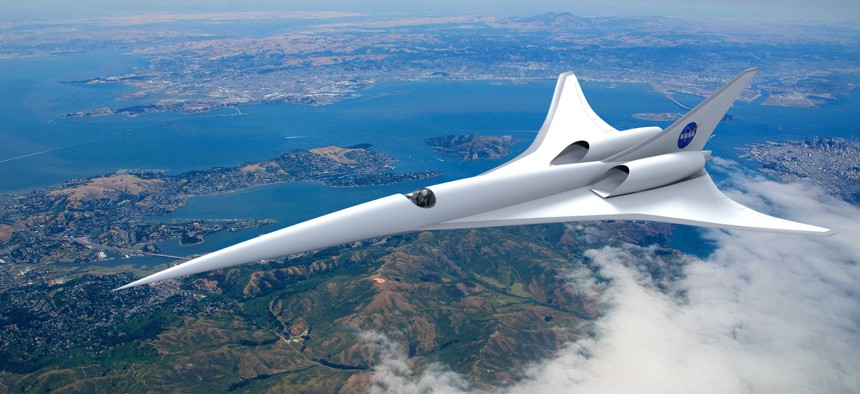
NASA illustration
NASA is Investing in Eco-friendly Supersonic Airplane Travel
Maybe by 2030 we'll be able to fly between London and New York in under four hours again.
Unless you have access to a F-22 fighter jet, you probably haven’t been able to fly faster than the speed of sound since the last Concorde flight in 2003. NASA wants to change this. The agency said that it is spending over $6 million to fund research into cheaper and greener supersonic travel.
This isn’t NASA’s first attempt to bring back supersonic travel. The agency has been (literally) pushing the boundaries of flight for years. NASA’s predecessor was involved in building the first supersonic plane in 1946, and the agency has been working on concepts since 2006 with companies like Lockheed-Martin and Boeing that may one day lead to a new generation of planes that get you places very quickly.
The largest awards of this round of funding went to MIT and Wyle Laboratories, a research contractor in Virginia, to investigate the environmental impact of commercial supersonic flight and how turbulence affects sonic booms, respectively.
MIT’s study will be looking into updating the environmental impact models created for NASA in the ’80s and ’90s. While many modern fighter jets have the ability to fly faster than the speed of sound, the environmental impact is relatively small, because there just aren’t thatmany fighter jets in operation. It would be a different case if commercial jets were capable of supersonic flight. There are roughly 7,000 flights over the US alone at any given time, all burning fuel to stay up there. Supersonic flight burns more fuel—albeit for a shorter period of time—than a traditional jet engine. NASA said that supersonic jets also travel at higher altitudes than regular jets, closer to the stratosphere, and so they have a greater potential to damage the ozone layer.
Another big chunk of the funds went into research on how to make supersonic travel quieter. For anyone who has ever been near the Concorde’s flight path, they’ll know that it was really, really loud. If supersonic jets are to become the norm, they’re going to have to get a lot quieter, or we’re all going to go deaf. NASA told Quartz that it’s already had some “pretty outstanding success” in past attempts to reduce the sound of supersonic booms.
Then there’s the running costs issue. The Concorde was a loss-leader for Air France (one of only two carriers that regularly flew the plane), but it was built by a French company and was regarded as a symbol of national pride. In an era when airlines are trying to cram more peopleonto existing planes, modern commercial supersonic jets would need to be economically viable before any company is likely to purchase one.
NASA said that if all goes to plan with these studies, it sees the first business-jet-sized supersonic planes going into production by 2025, and commercial planes by 2030. For now, we’ll have to stick to spending inordinate amounts of time and fuel to fly anywhere.






